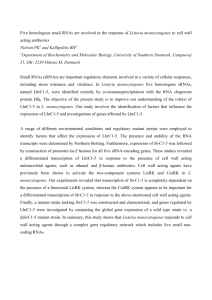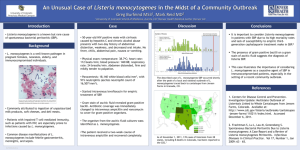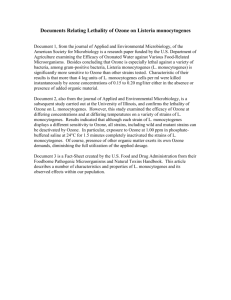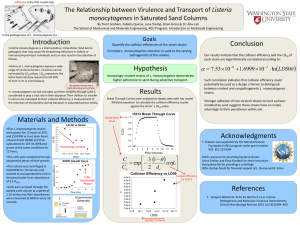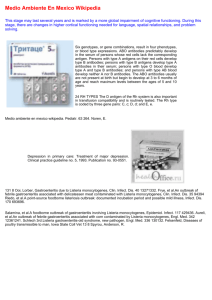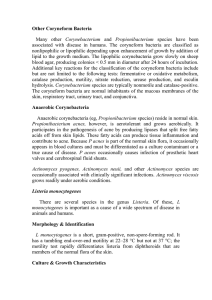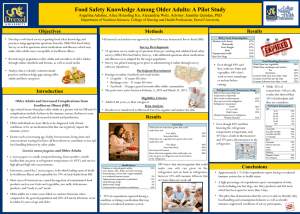Advance Journal of Food Science and Technology 6(9): 1076-1079, 2014
advertisement
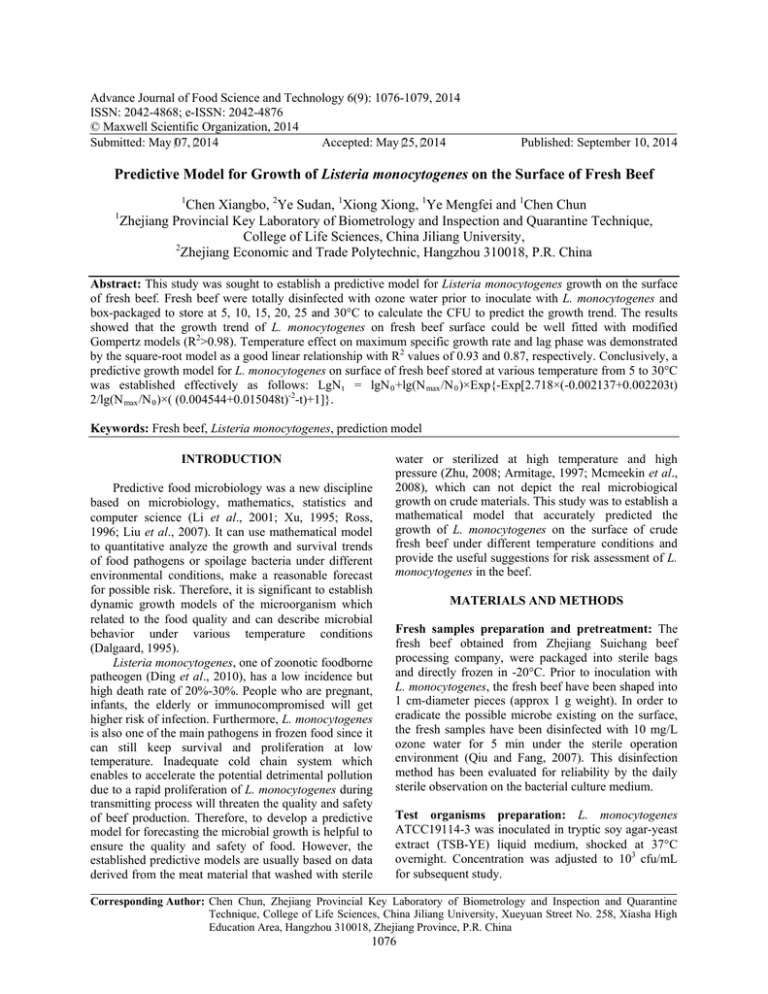
Advance Journal of Food Science and Technology 6(9): 1076-1079, 2014
ISSN: 2042-4868; e-ISSN: 2042-4876
© Maxwell Scientific Organization, 2014
Submitted:
May 07, 2014
Accepted: May 25, 2014
Published: September 10, 2014
Predictive Model for Growth of Listeria monocytogenes on the Surface of Fresh Beef
1
Chen Xiangbo, 2Ye Sudan, 1Xiong Xiong, 1Ye Mengfei and 1Chen Chun
Zhejiang Provincial Key Laboratory of Biometrology and Inspection and Quarantine Technique,
College of Life Sciences, China Jiliang University,
2
Zhejiang Economic and Trade Polytechnic, Hangzhou 310018, P.R. China
1
Abstract: This study was sought to establish a predictive model for Listeria monocytogenes growth on the surface
of fresh beef. Fresh beef were totally disinfected with ozone water prior to inoculate with L. monocytogenes and
box-packaged to store at 5, 10, 15, 20, 25 and 30°C to calculate the CFU to predict the growth trend. The results
showed that the growth trend of L. monocytogenes on fresh beef surface could be well fitted with modified
Gompertz models (R2>0.98). Temperature effect on maximum specific growth rate and lag phase was demonstrated
by the square-root model as a good linear relationship with R2 values of 0.93 and 0.87, respectively. Conclusively, a
predictive growth model for L. monocytogenes on surface of fresh beef stored at various temperature from 5 to 30°C
was established effectively as follows: LgN t = lgN 0 +lg(N max /N 0 )×Exp{-Exp[2.718×(-0.002137+0.002203t)
2/lg(N max /N 0 )×( (0.004544+0.015048t)-2-t)+1]}.
Keywords: Fresh beef, Listeria monocytogenes, prediction model
INTRODUCTION
Predictive food microbiology was a new discipline
based on microbiology, mathematics, statistics and
computer science (Li et al., 2001; Xu, 1995; Ross,
1996; Liu et al., 2007). It can use mathematical model
to quantitative analyze the growth and survival trends
of food pathogens or spoilage bacteria under different
environmental conditions, make a reasonable forecast
for possible risk. Therefore, it is significant to establish
dynamic growth models of the microorganism which
related to the food quality and can describe microbial
behavior under various temperature conditions
(Dalgaard, 1995).
Listeria monocytogenes, one of zoonotic foodborne
patheogen (Ding et al., 2010), has a low incidence but
high death rate of 20%-30%. People who are pregnant,
infants, the elderly or immunocompromised will get
higher risk of infection. Furthermore, L. monocytogenes
is also one of the main pathogens in frozen food since it
can still keep survival and proliferation at low
temperature. Inadequate cold chain system which
enables to accelerate the potential detrimental pollution
due to a rapid proliferation of L. monocytogenes during
transmitting process will threaten the quality and safety
of beef production. Therefore, to develop a predictive
model for forecasting the microbial growth is helpful to
ensure the quality and safety of food. However, the
established predictive models are usually based on data
derived from the meat material that washed with sterile
water or sterilized at high temperature and high
pressure (Zhu, 2008; Armitage, 1997; Mcmeekin et al.,
2008), which can not depict the real microbiogical
growth on crude materials. This study was to establish a
mathematical model that accurately predicted the
growth of L. monocytogenes on the surface of crude
fresh beef under different temperature conditions and
provide the useful suggestions for risk assessment of L.
monocytogenes in the beef.
MATERIALS AND METHODS
Fresh samples preparation and pretreatment: The
fresh beef obtained from Zhejiang Suichang beef
processing company, were packaged into sterile bags
and directly frozen in -20°C. Prior to inoculation with
L. monocytogenes, the fresh beef have been shaped into
1 cm-diameter pieces (approx 1 g weight). In order to
eradicate the possible microbe existing on the surface,
the fresh samples have been disinfected with 10 mg/L
ozone water for 5 min under the sterile operation
environment (Qiu and Fang, 2007). This disinfection
method has been evaluated for reliability by the daily
sterile observation on the bacterial culture medium.
Test organisms preparation: L. monocytogenes
ATCC19114-3 was inoculated in tryptic soy agar-yeast
extract (TSB-YE) liquid medium, shocked at 37°C
overnight. Concentration was adjusted to 103 cfu/mL
for subsequent study.
Corresponding Author: Chen Chun, Zhejiang Provincial Key Laboratory of Biometrology and Inspection and Quarantine
Technique, College of Life Sciences, China Jiliang University, Xueyuan Street No. 258, Xiasha High
Education Area, Hangzhou 310018, Zhejiang Province, P.R. China
1076
Adv. J. Food Sci. Technol., 6(9): 1076-1079, 2014
Temperature variation studies: 0.1 ml L.
monocytogenes liquid culture with 103 cfu/mL ultimate
concentration was added on the surface of beef
samples, then they were incubated in 2×2 cm sterile
medicine box for subsequent growth observation with
various temperature treatments described as follows.
Treatments under 5°C incubated for 28 d were counted
with CFU every 2 d. Treatments under 10°C incubated
for 14 d were counted with CFU every 24 h, Treatments
under 15°C incubated for 156 h were counted with CFU
every 12 h, Treatments under 20°C incubated for 88 h
were counted with CFU every 8 h; Treatments under
25°C incubated for 40 h were counted with CFU every
4 h; Treatments under 30°C were counted with CFU by
2, 4, 6, 8, 10, 15, 20, 25, 30 and 35 h, respectively. All
tests were repeated three times. All samples were
washed by 3 mL physiological saline then the liquid
residues were incubated on the Brian Heart Infusion
(BHI) agarose for CFU-counting with the Chinese
national standards (GB 47892, 2010).
μ max = The maximum specific growth rate of microbe
λ
= Microbial lag phase time
•
Square root model as secondary growth model:
The square root equation, presented by Ratkowsky
et al. (1982), Buchanan et al. (1997) and Baranyi
and Roberts (1994) as an experience model which
could describe the linear relationship of
microorganisms under different temperature
conditions between growth rate or inverse square
root of lag phase and effective temperature, could
well illustrate the growth of microorganisms under
different temperature conditions. The formula is as
follows:
µ
1
max
= bµ × (T − Tmin µ )
=
λ b
λ
× (T − Tmin λ )
(2)
(3)
Predictive model development:
•
Growth predictive model of colonies number as
primary growth model: Gompertz model can well
describe the growth trend of microorganism. In this
study, a modified Gompertz equation was
developed to describe the growth of L.
monocytogenes under various temperatures. The
equation is following:
LgN t = lgN 0 +lg(N max /N 0 )×Exp{-Exp
[2.718×μ max /lg(N max /N 0 )×(λ-t)+1]}
In the Eq. (2) and (3), where T is the Celsius
temperature (°C) and T min is a hypothetical value,
represented the temperature when specific growth
rate is zero, parameter b is the constant value.
•
RESULTS AND DISCUSSION
(1)
where,
= The number of viable microorganisms at
Nt
various temperature
= The initial microbial number
N0
N max = The maximum microbial number in stable
phase
Statistics analysis: All analysis and statistics in
this study were performed by DPS software (Tang
and Feng, 2002).
Growth curve of L. monocytogenes under various
temperatures condition: Growth curves of L.
monocytogenes under various temperatures were
illustrated in Fig. 1. A, B, C, D represented the growth
curve of L. monocytogenes at 30, 25, 20 and 15°C,
respectively. These curves showed as a steep rise in the
Fig. 1: Growth curve of L. monocytogenes at various temperatures. A, B, C, D, E and F represent the growth curve of L.
monocytogenes at 30°C, 25°C, 20°C, 15°C, 10°C and 5°C, respectively
1077
Adv. J. Food Sci. Technol., 6(9): 1076-1079, 2014
Fig. 2: Growth tendency of L. monocytogenes on the surface of fresh beef at various temperatures (Solid dots: observation
values, solid line: fitted curve). The equation shows the estimated parameter of modified Gompertz model under relevant
temperatures. All parameters are highly significant (p<0.01) and the correlation coefficient (R2) is more than 0.98
first 96 h culture period obviously suggested that L.
monocytogenes could rapidly grow at the range of 15 to
35°C and the concentration may reach the risk
threshold of food safety during those culture periods.
The upward trend of the curves E and F (the growth
curve of L. monocytogenes at 10 and 5°C) were not
showed up obviously but began to rise rapidly after 96
h. It showed that L. monocytogenes could also cause
huge risks in low temperature condition as the time
extended.
Primary growth model of L. monocytogenes: Figure 2
showed that the modified Gompertz equation can better
predict the dynamic growth of L. monocytogenes at 30,
25, 20, 15, 10 and 5°C, respectively. Gompertz model
was used to fit the experimental data by the optimized
method of Marquardt. Additionally, Kinetic parameters
in Table 1 demonstrated that maximum number in
stable phase (N max ) of L. monocytogenes was
11.9015±0.6322 at the condition of 20°C and the
minimum value was 9.8324±0.4249 at the condition of
30°C. The maximum specific growth rate (μ max )
increased with the temperature increasing. The
maximum value of μ max was 0.004399153/h at the
condition of 30°C, the minimum value was
0.00020901/h at the condition of 5°C as well. The time
of lag phase (λ) was decreasing as the temperature
increasing. The maximum value was 131.974 at 5°C;
the minimum value was 2.3799 h occurred at 30/ °C.
Table 1: Kinetic parameters of L. monocytogenes grown on the surface of fresh
beef at various temperatures based on modified Gompertz model
T/°C
N max [lg(CFU)]
μ max /h
λ/h
SSE
R2
5
10.6198±0.1313
0.000209010
131.974
0.0071
0.9995
10
11.2159±0.5605
0.000320914
57.9883
0.0576
0.9954
15
10.4305±0.3402
0.000796294
22.0952
0.0333
0.9972
20
11.9015±0.6322
0.001106983
6.83070
0.0830
0.9940
25
10.5239±0.2660
0.003395614
8.77400
0.0162
0.9989
30
9.8324±0.42490
0.004399153
2.37990
0.1052
0.9929
performed to describe the influence of different
temperature for the maximum specific growth rate
(μ max ) and the time of lag phase (λ). Fitness of the curve
of maximum specific growth rate-temperature pair
(�𝜇𝜇𝑚𝑚𝑚𝑚𝑚𝑚 − 𝑡𝑡) and lag phase-temperature pair (�1�𝜆𝜆 − 𝑡𝑡)
were calculated by DPS statistical software. As results,
the equation of relationship between temperature and
maximum growth rate and lag phase are following:
�𝜇𝜇𝑚𝑚𝑚𝑚𝑚𝑚 = -0.002137+0.002203T
�1�𝜆𝜆 = 0.004544+0.015048T
(4)
(5)
In those equations, correlation coefficients (R2) are
0.93 and 0.87, respectively. b = 0.002203 and T min =
0.97041 can be calculated according to the Eq. (4). So
we infer that L. monocytogenes could grow at 0.97°C
theoretically. By merging Eq. (4) and (5) into Eq. (1),
the growth kinetics model of L. monocytogenes at 530°C in fresh beef could be acquired. The equation is as
follow:
Development and verification of secondary growth
model: As the limits of primary model (demonstrated
as Gompertz model above), square root equation was
1078
LgN t = lgN 0 +lg(N max /N 0 )×Exp{-Exp[2.718×
Adv. J. Food Sci. Technol., 6(9): 1076-1079, 2014
(-0.002137+0.002203t)2/lg(N max /N 0 )×
((0.004544+0.015048t)-2-t)+1]}
CONCLUSION
Conclusively, the primary growth model of
Gompertz equation could well describe the growth of L.
monocytogenes under various temperatures on the
surface of fresh beef and secondary model of square
root could fit well the bacteria growth rate and the time
of lag phase. In addition, the results showed that L.
monocytogenes could grow at 0.97°C which consistent
with one of their biological traits (could grow under
low-temperature) and this could improve their health
hazard being a food borne pathogen. Therefore, our
experimental data have embodied the general trend of
the bacterial growth and can predict the growth of L.
monocytogenes under various temperatures, enrich the
database of L. monocytogenes proliferation in various
meats. However, this study only developed the
predictive model about the growth of L. monocytogenes
at multiple constant temperatures but not at the variable
temperature, so the influence of temperature fluctuation
during transportation on their growth in beef still need
further research.
REFERENCES
Armitage, N.H., 1997. Use of predictive microbiology
in meat hygiene regulatory activity. Int. J. Food
Microbiol., 36: 103-109.
Baranyi, J. and T.A. Roberts, 1994. A dynamic
approach to predicting bacterial growth in food.
Int. J. Food Microbiol., 23(3/4): 277-294.
Buchanan, R.L., R.C. Whiting and W.C. Damert, 1997.
When is simple good enough: A comparison of the
Gompertz, Baranyi and three-phase linear models
for fitting bacterial growth curves. Food
Microbiol., 14: 313-326.
Dalgaard, P., 1995. Modelling of microbial activity and
prediction of shelf life for packed fresh fish. Int. J.
Food Microbiol., 26(3): 305-317.
Ding, T., Q.L. Dong, L. Wang, M.H. Ma and Y.G. Jin,
2010. Establishment and validation of predictive
model for Listeria monocytogenes in broth. J.
Huazhong Agric. Univ., 29(4): 522-526.
GB 47892, 2010. Food microbiological examination:
Aerobic plate count. National Food Safety
Standard.
Li, B., L.T. Li and E. Tatsumi, 2001. Development of
predictive microbiology. Food Fermentation Ind.,
27(11): 54-57.
Liu, W., W.D. Liu and H.Q. Ying, 2007. Predictive
microbiology and the application in the field of
food safety. Chin.
Preventive Med., 8(4):
511-512.
Mcmeekin, T.A., J. Bowman and O. Mcquestin, 2008.
The future of predictive microbiology: Strategic
research, innovative applications and great
expectations. Int. J. Food Microbiol., 128(1): 2-9.
Qiu, J. and Y.M. Fang, 2007. Evaluation of germicidal
efficacy of ozone water by two methods. Chin. J.
Disinfect., 24(6): 515-517.
Ratkowsky, D.A., J. Olley, T.A. McKeekin and A. Ball,
1982. Relationship between temperature and
growth rate of bacterial cultures. J. Bacteriol., 149:
1-5.
Ross, T., 1996. Indices for performance evaluation of
predictive models in food microbiology. J. Appl.
Bacteriol., 81: 501-508.
Tang, Q.Y. and M.G. Feng, 2002. DPS Data Processing
System for Practical Statistics. Science Press,
Beijing.
Xu, T.Y., 1995. The forecast model of food
microorganism growth. Food Sci., 16(1): 17-21.
Zhu, T.M., 2008. Dulplex PCR Identification and
Molecular Typing of Listeria monocytogenes in
Frozen
Products.
Huazhong
Agricultural
University Library, Wuhan.
1079
